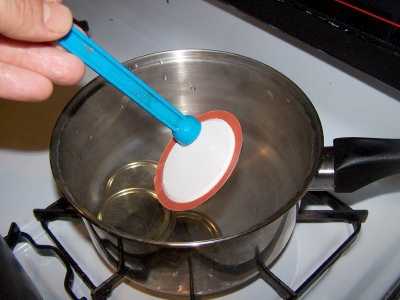
Looking for Cleaning and Sanitizing Canning Jars Prior to Filling Them in 2025? Scroll down this page and follow the links. And if you bring home some fruit or vegetables and want to can, freeze, make jam, salsa or pickles, see this page for simple, reliable, illustrated canning, freezing or preserving directions. There are plenty of other related resources, click on the resources dropdown above. If you are having a hard time finding canning lids, I've used these, and they're a great price & ship in 2 days.
If you have questions or feedback, please let me know! There are affiliate links on this page. Read our disclosure policy to learn more.
Cleaning and Sanitizing Canning Jars Prior to Filling Them
 Cleaning
and Sanitizing
Canning Jars Prior to Filling Them
Cleaning
and Sanitizing
Canning Jars Prior to Filling Them
It's pretty obvious that canning equipment, jars, lids, etc need to be clean to avoid spoilage and food poisoning. But how to clean and the definition of clean may need some clarification.
Sterilizing vs. Sanitizing
Most people refer to making surfaces free of germs and safe as "sterilizing". In practice, true sterilization is impossible to achieve in a home, so food scientists refer to "sanitizing" equipment and jars.
They recommend that all jars used for home food preservation, such as jams, jellies, and pickled products which processed less than 10 minutes in a canner should be filled into sanitized empty jars. If the jar will br processed for more than 10 minutes in a canner (water bath or pressure canner) then the canner does the job of killing germs and sanitizing the jar. But in practice, whether the recipe calls for 5 minutes, 10 minutes or 50 minutes of processing common sense tells us we ought to make sure the jars are as clean as we can practically make them.
How to sanitize jars
To sterilize empty jars, put them right side up on the rack in a
boiling-water canner. Fill the canner and jars with hot (not
boiling) water to 1 inch above the tops of the jars. Boil 10 minutes
at altitudes of less than 1,000 ft. At higher elevations, boil 1
additional minute for each additional 1,000 ft. elevation. Remove
and drain hot sterilized jars one at a time. Save the hot water for
processing filled jars. Fill jars with food, add lids, and tighten
screw bands.
Many newer dishwashers now have a "sanitize" cycle which is design to accomplish the sanitizing above. I do this right before I use the jars, and keep them in the dishwasher staying hot until I use them.
How to sanitize lids
Canning lids have a glue around the edge that seals against the jar. For this reason, we don't warm the lids to soften the adhesive. Instead we put them in very hot water (180 - 200 F ) (or 85 - 95 C)for about 10 minutes. I just leave the lids in this hot water over very, very low heat until I am ready to use them. This not only sanitizes the lids, but also softens the sealing surface to make a better seal.
You don't need to sanitize the rings since they do not come in contact with the food!
Results
Using the approach above, I rarely EVER have a jar sospoil!
Adapted from the "Complete Guide to Home Canning," Agriculture Information Bulletin No. 539, NIFA-USDA (Revised 2015). Page reviewed February 2, 2017.
Looking for canning equipment and supplies?
Water bath canner with a jar rack
Pressure canners for gas, electric and induction stoves: Presto 23Qt or T-fal 22Qt
Canning scoop (this one is PERFECT)
Ball Blue book (most recent version)
Jars: 8oz canning jars for jams
Find Other types of farms:
Farm markets and roadside stands
Road trips and camping resources
Local Honey, apiaries, beekeepers
Consumer fraud and scams information
Home canning supplies at the best prices on the internet!
Maple Syrup Farms, sugarworks, maple syrup festivals
Environmental information and resources
Farms For Your Event for birthday parties, weddings, receptions, business meetings, retreats, etc.
Festivals - local fruit and vegetable festivals
Get the
most recent version of
the Ball Blue Book
With this Presto 23 quart pressure canner and pressure cooker, you can "can" everything, fruits, vegetables, jams, jellies, salsa, applesauce, pickles, even meats, soups, stews. Model 01781

You can make jams, jellies, can fruit, applesauce, salsa and pickles with water bath canners, like this Granite Ware 12-Piece Canner Kit, Jar Rack, Blancher, Colander and 5 piece Canning Tool Set

